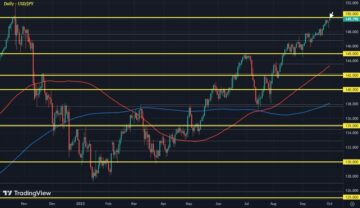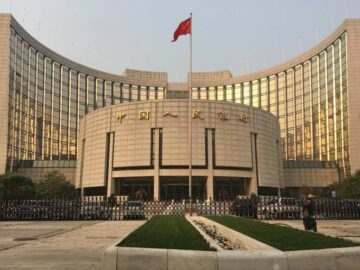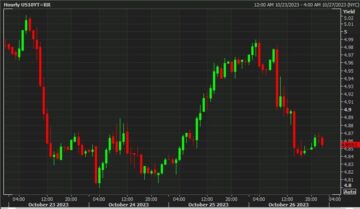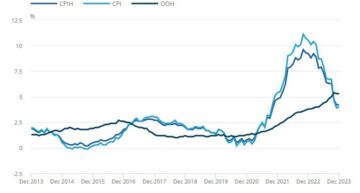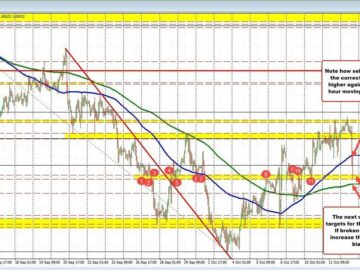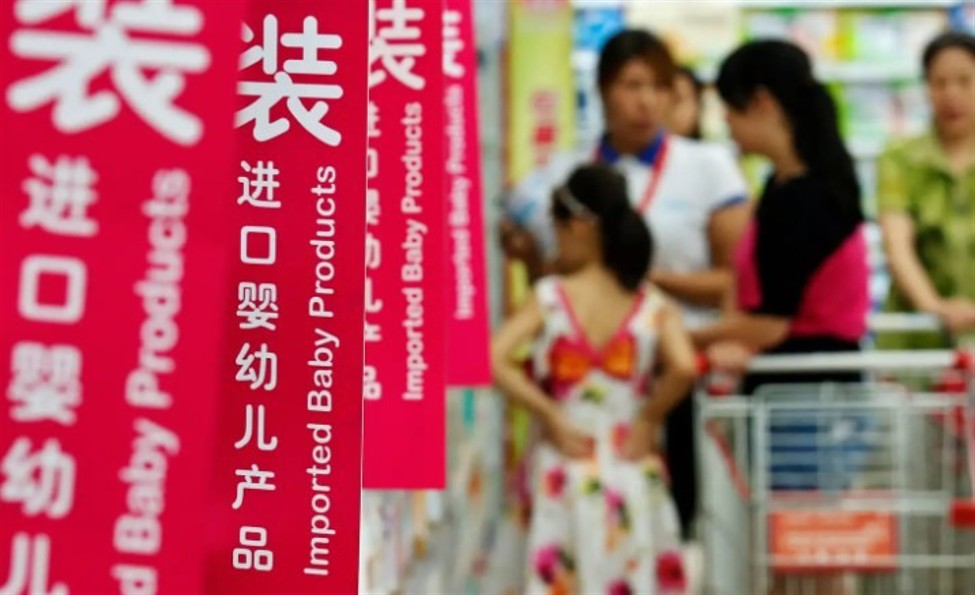
Consumer price inflation data from China for February 2024 shows an exit from deflation
CPI +0.7% y/y
- expected +0.3%, prior -0.8% (that -0.8% in January was the sharpest the steepest fall in more than 14 years)
- for the m/m, comes in at +1.0% (prior +0.3%)
- first rise in the CPI since August of 2023
- core CPI +1.2% y/y (prior +0.4%)
PPI -2.7% y/y
- expected -2.5%, prior -2.5%
- for the m/m, comes in at -0.2%
Thats a very large jump in CPI from -0.8% y/y in January to +0.7% in February. Its not as if the yuan collapsed, which would ramp up the price of imports.
ADDED – China National Bureau of Statistics (NBS) on the CPIrise:
- “It was primarily food and service prices that rose more”
“During the Spring Festival period, consumer demand for food products grew, in addition to rainy and snowy weather in some regions affecting supply”
—
Well, that ends the ‘deflation narrative’ in China. This is welcome news, deflation weighs on the economy in multiple ways:
- When prices are falling, consumers may delay purchases in anticipation of even lower prices in the future. This reduction in spending can lead to decreased demand for goods and services, slowing down economic growth.
- Deflation increases the real value of debt, making it more expensive for borrowers to repay loans. This can lead to higher default rates and can stress financial institutions. Individuals and businesses may cut back on spending and investment as a result.
- As prices fall, revenues for companies decrease, but many of their costs (like loans, leases, and salaries) do not adjust downward as quickly. This can lead to lower profits, cutbacks in production, and layoffs, further contributing to the economic downturn.
- Wages tend to be sticky downwards, meaning they do not easily decrease even when there is deflation. This can lead to higher labor costs relative to revenues for businesses, forcing them to reduce their workforce or halt hiring.
- With falling prices, the return on investments can be lower than expected, or even negative. This can lead to a reduction in investments by businesses in areas like research and development, new projects, or expansion.
- The most dangerous aspect of deflation is the risk of a deflationary spiral. This occurs when falling prices lead to lower production, leading to higher unemployment, leading to lower demand, and thus further declines in prices. This vicious cycle can be very difficult to break and can lead to long-term economic stagnation.
- SEO Powered Content & PR Distribution. Get Amplified Today.
- PlatoData.Network Vertical Generative Ai. Empower Yourself. Access Here.
- PlatoAiStream. Web3 Intelligence. Knowledge Amplified. Access Here.
- PlatoESG. Carbon, CleanTech, Energy, Environment, Solar, Waste Management. Access Here.
- PlatoHealth. Biotech and Clinical Trials Intelligence. Access Here.
- Source: https://www.forexlive.com/news/china-february-cpi-07-yy-expected-03-ppi-27-yy-expected-25-20240309/
- :is
- :not
- $UP
- 14
- 2%
- 2024
- a
- addition
- adjust
- affecting
- an
- and
- anticipation
- ARE
- areas
- AS
- aspect
- At
- AUGUST
- back
- BE
- borrowers
- Break
- Bureau
- businesses
- but
- by
- CAN
- China
- collapsed
- comes
- Companies
- consumer
- Consumers
- contributing
- Costs
- CPI
- Cut
- cycle
- Dangerous
- data
- Debt
- Declines
- decrease
- decreased
- Default
- deflation
- deflationary
- delay
- Demand
- Development
- difficult
- do
- down
- DOWNTURN
- downward
- during
- easily
- Economic
- economic downturn
- Economic growth
- economy
- ends
- Even
- Exit
- expansion
- expected
- expensive
- Fall
- Falling
- February
- FESTIVAL
- financial
- Financial institutions
- food
- For
- forcing
- from
- further
- future
- goods
- grew
- Growth
- higher
- Hiring
- HTTPS
- if
- imports
- in
- Increases
- individuals
- inflation
- institutions
- investment
- Investments
- IT
- ITS
- January
- jpg
- jump
- labor
- large
- layoffs
- lead
- leading
- leases
- like
- Loans
- long-term
- lower
- Making
- many
- May..
- meaning
- more
- most
- multiple
- NARRATIVE
- National
- negative
- New
- news
- of
- on
- or
- period
- plato
- Plato Data Intelligence
- PlatoData
- ppi
- price
- Prices
- primarily
- Prior
- Production
- Products
- profits
- projects
- purchases
- quickly
- Ramp
- Rates
- real
- real value
- reduce
- reduction
- regions
- relative
- repay
- research
- research and development
- result
- return
- revenues
- Rise
- Risk
- ROSE
- salaries
- service
- Services
- Sharpest
- Shows
- since
- Slowing
- some
- Spending
- spiral
- spring
- STAGNATION
- statistics
- sticky
- stress
- supply
- tend
- than
- that
- The
- The Future
- their
- Them
- There.
- they
- this
- Thus
- to
- unemployment
- value
- very
- was
- ways
- Weather
- weighs
- welcome
- when
- which
- Workforce
- would
- years
- Yuan
- zephyrnet
More from Forex Live
China’s State Planner Vice Chairman flags 6 trln yuan available for government investment | Forexlive
Source Node: 2521034
Time Stamp: Mar 20, 2024
Japan’s next CPI data will show core inflation above target for the 17th straight month | Forexlive
Source Node: 2271080
Time Stamp: Sep 14, 2023
Forexlive Americas FX news wrap: Big gains for stocks, FX unimpressed | Forexlive
Source Node: 2378503
Time Stamp: Nov 10, 2023
RBA Governor Bullock says the Bank is increasingly optimistic about the labour market | Forexlive
Source Node: 2391233
Time Stamp: Nov 20, 2023
Deutsche Bank cuts China full year GDP growth forecast to 5.3% from 6.0% previously | Forexlive
Source Node: 2174746
Time Stamp: Jul 18, 2023
ECB’s Patsalides says central bank decisions are reliant on data | Forexlive
Source Node: 2553930
Time Stamp: Apr 22, 2024
Oil is moving higher – watch out for the Middle East weekend risk premium | Forexlive
Source Node: 2350221
Time Stamp: Oct 26, 2023
UK December CPI +4.0% vs +3.8% y/y expected | Forexlive
Source Node: 2444553
Time Stamp: Jan 17, 2024
EURUSD extends to a new low and looks toward its 200 hour moving average | Forexlive
Source Node: 2322953
Time Stamp: Oct 12, 2023

